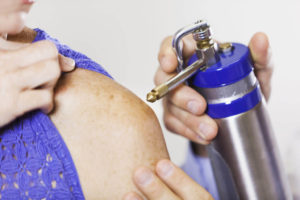Actinic Keratosis

Actinic Keratosis Causes
AKs are caused by chronic sun exposure. Sun damage to the ones skin is cumulative, so even brief sun exposure periods adds to a lifetime total. Contrary to popular belief, cloudy days aren’t safe because 70-80 percent of ultraviolet (UV) rays can pass through clouds. These harmful rays can also bounce off snow, sand and other reflective surfaces which give you extra sun exposure. Ultraviolet radiation given off by lamps in tanning salons can be even more dangerous than the sun. Dermatologists warn against using indoor tanning beds at all costs.
Actinic Keratosis Treatments
Actinic keratosis is the most common pre-cancer but not all keratosis turn into skin cancers. There is no way to know ahead of time which AKs will turn into skin cancers, such as squamous cell carcinomas. Fortunately there are many effective treatments for eliminating AKs.
Topical medications such as imiquimod or 5-Fluorouracil are very effective in treating AKs. These may be used in combination with other forms of treatment, especially when the patient has many actinic keratosis.
5-Fluorouracil (Efudex, Carac) is the most widely used topical treatment for AKs. It is effective against surface lesions as well as the subclinical ones. Patients are instructed to rub the cream gently onto the lesions one or twice a day for two to four weeks. It produces cure rates of up to 90 percent. Temporary reactions may include redness, swelling and crusting of the lesions. These lesions usually heal within two weeks after treatment.
Cryosurgery is the most commonly used treatment for actinic keratosis when there is a limited number of lesions. Liquid nitrogen is sprayed on the growths and freezes them. The lesions shrink or become crusted over and eventually fall off. Temporary redness and swelling may occur after cryosurgery.
Chemical peels are another treatment option for AK’s. A chemical solution chosen by our dermatologist is applied to your skin. Depending on the depth and strength of the peel, your skin will peel for the next several days. New skin will replace the area treated by the peel. Side effects include redness and swelling of the skin that was treated.
Photodynamic Therapy (PDT) is a treatment that greatly improves sun-damaged skin and AK’s. PDT therapy uses drugs called photosensitizing agents along with a BLU-U light to kill precancerous skin cancer cells as well as cancerous cells. The topical photosensitizing agent called Levulan is applied to the area being treated. The light from the BLU-U light converts the Levulan which removes the targeted cells. Additional benefits includes improved skin texture and tone.
To learn more about actinic keratosis, or to schedule your consultation with Board-Certified Dermatologist Dr. Weyer, please fill out the form on this page. You can call our Tucson location at 520-207-3100 or our Sierra Vista location at 520-458-1787. We look forward to seeing you soon!

